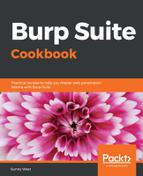There are a number of text conventions used throughout this book.
CodeInText: Indicates code words in text, database table names, folder names, filenames, file extensions, pathnames, dummy URLs, user input, and Twitter handles. Here is an example: "Allow the attack to continue until you reach payload 50."
A block of code is set as follows:
<script>try{var m = "";var l = window.localStorage; var s =
window.sessionStorage;for(i=0;i<l.length;i++){var lKey = l.key(i);m
+= lKey + "=" + l.getItem(lKey) +
";
";};for(i=0;i<s.length;i++){var lKey = s.key(i);m += lKey + "="
+ s.getItem(lKey) +
";
";};alert(m);}catch(e){alert(e.message);}</script>
Any command-line input or output is written as follows:
user'+union+select+concat('The+password+for+',username,'+is+',+pass
word),mysignature+from+accounts+--+
Bold: Indicates a new term, an important word, or words that you see onscreen. For example, words in menus or dialog boxes appear in the text like this. Here is an example: "Select a tool from the drop-down listing and click the Lookup Tool button."
Warnings or important notes appear like this.
Tips and tricks appear like this.
